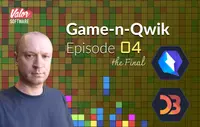The Final Stitches.
Congratulations! We are in the final stretch! Let’s summarize our previous points.
In Episode 01, I introduced you to the Columns Game history and concept.
Episode 02 is devoted to initial technical points like Bootstrapping, Libraries, and gameplay’s first steps.
Episode 03 is the most complicated and exciting. In this episode, we passed all the mandatory steps to get the natural Qwik Columns gameplay.

Despite the above, our current solution still needs to be finished for the reasons below.
A player can set the game on pause.
Move the actor somehow immediately to the bottom of the board. This feature is essential because, in many cases, a player has decided on the final actor’s color combination, and the player wants to drop it to the bottom immediately. Moreover, the dropping above is preferable to be animated.
Provide visual controls "Start," "Stop," and "Pause" as a set of buttons.
Provide different customized speeds for the moving actor, like "Slow," "Normal," and "Fast," with related score calculation. Slow speed gives us less score; Fast pace gives us more.
Visual end of the game. Currently, we have only "console.log" when the game has finished.
UI footer, preferably UI responsive. Traditionally I’ll explain all my modifications step by step. My impatient readers can read and run the final working solution.
If you want to trace future steps with me, please use the destination code from the previous episode.
Let’s get started!
Gameplay changes
First, let’s deal with src/components/game-play/game-logic.ts. Please, read my comments in the code!
Pay attention to the new Phase
export enum Phase {
INACTIVE,
// Pause is ON
PAUSED,
MOVING,
// Drop is requested
DROP,
// Drop action is under progress
FLYING,
MATCH_REQUEST,
COLLAPSE_REQUEST,
}and change the main game definition.
export interface Game {
board: ColumnsColor[][];
actor: Actor;
phase: Phase;
// we need to save our current phase before pause
savedPhase: Phase;
nextActor: ColumnsColor[];
score: number;
// this is a key/value-based score descriptors
// key describes type of speed, Slow, Normal, Fast
// value is a related score extent
scores: { [key: string]: number };
}Pass current speed (Level) to matching function. It’s needed for score calculation.
export function matching(
game: Game,
// new parameter
level: Level,
mark: boolean,
customBoard?: ColumnsColor[][]
) {
// ...
function checkCollapsed(match: boolean[][], mark: boolean): boolean {
let result = false;
for (let row = 0; row < rowsQty; row++) {
for (let col = 0; col < columnsQty; col++) {
if (match[row][col]) {
if (mark) {
board[row][col] = colorsToDisappearHash[board[row][col]];
// calculate the score according to the level
game.score += game.scores[level];
}
result = true;
}
}
}
return result;
}
// ...
return checkCollapsed(match, mark);
}isFinish should also know about the level
export function isFinish(game: Game, level: Level): boolean {
// ...
if (matching(game, level, false, getNextBoard())) {
return false;
}
// ...
}Add pause implementation.
export function pause(game: Game) {
if (game.phase === Phase.PAUSED) {
game.phase = game.savedPhase;
} else {
game.savedPhase = game.phase;
game.phase = Phase.PAUSED;
}
}That’s it regarding the gameplay definitions. It’s time to focus on src/components/game-play/game.tsx
There are the expected definitions.
// Levels definitions
export enum Level {
SLOW = "SLOW",
NORMAL = "NORMAL",
FAST = "FAST",
}
// Connects levels with the interval speeds in milliseconds
export const SPEEDS = {
[Level.SLOW]: 1000,
[Level.NORMAL]: 500,
[Level.FAST]: 200,
};
// Connects levels with the scores
export const SCORES = {
[Level.SLOW]: 1,
[Level.NORMAL]: 2,
[Level.FAST]: 3,
};Please, look at the following fragment of code. We need to draw the actor also if the phase is PAUSED and DROP.
There are the following changes in the store
export interface MainStore {
width: number;
height: number;
game: Game;
blockSize: number;
// Add the level
level: Level;
// We need to control intervalId (start, stop).
// It's important in the context of Controls (see above).
intervalId: any | null;
gameOverPopup: boolean;
}and related changed for the initial state.
const store = useStore<MainStore>({
width: 0,
height: 0,
game: {
board: [...initData],
actor: {
state: [...initActor],
column: Math.floor(initData[0].length / 2),
row: -2,
},
// Start from INACTIVE instead MOVING.
// Now the game is inactive and the user should press Play button.
phase: Phase.INACTIVE,
// add this one...
savedPhase: Phase.INACTIVE,
nextActor: randomColors(3),
score: 0,
scores: SCORES,
},
blockSize: 0,
// initial level will be NORMAL
level: Level.NORMAL,
// add this one...
intervalId: null,
gameOverPopup: false,
});An important note regarding Qwik!
At this point, I’d like to interrupt my telling and share one tricky Qwik feature with you. The following information has been taken from the official Qwik documentation.
According to Qwik Deep Objects
export const MyComp = component$(() => {
const store = useStore({
person: { first: null, last: null },
location: null,
});
store.location = { street: "main st" };
return (
<section>
<p>
{store.person.last}, {store.person.first}
</p>
<p>{store.location.street}</p>
</section>
);
});In the above examples, Qwik will automatically wrap child objects person and location into a proxy and correctly create subscriptions on all deep properties.
The wrapping behavior described above has one surprising side-effect. Writing and reading from a proxy auto wraps the object, which means that the identity of the object changes. This should normally not be an issue, but it is something that the developer should keep in mind.
export const MyComp = component$(() => {
const store = useStore({ person: null });
const person = { first: "John", last: "Smith" };
store.person = person; // store.person auto wraps object into proxy
if (store.person !== person) {
// The consequence of auto wrapping is that the object identity changes.
console.log("store auto-wrapped person into a proxy");
}
});Let’s continue and move all core logic to a separate moveTick function. Please, read my comments there. Uncommented logic is the same as in the previous episode.
// Create a separate function
const moveTick = $(() => {
const game = store.game;
// Do nothing if the actor is under dropping, I'll explain it below.
if (game.phase === Phase.FLYING) {
return;
}
if (game.phase === Phase.MOVING) {
if (isNextMovePossible(game)) {
actorDown(game);
} else {
endActorSession(game);
// Pass the level.
if (isFinish(game, store.level)) {
game.phase = Phase.INACTIVE;
store.gameOverPopup = true;
} else {
game.phase = Phase.MATCH_REQUEST;
}
}
// If the current phase is DROP.
} else if (game.phase === Phase.DROP) {
// We actually don't need to change the current state of the game
// that's why we create a clone of the game
const gameClone = clone(game);
// Calculate how many steps should be passed to reach the bottom.
let steps = 0;
// Iterate until the next move is possible.
while (isNextMovePossible(gameClone)) {
// Move the actor (on the cloned game) one step down.
actorDown(gameClone);
// Increase the steps counter
steps++;
}
// Pass the related steps to the "render" function.
// It causes the DROP animation running. I'll explain it a bit later.
reRender(steps);
return;
} else if (game.phase === Phase.MATCH_REQUEST) {
// Pass the level
const matched = matching(game, store.level, true);
if (matched) {
game.phase = Phase.COLLAPSE_REQUEST;
} else {
doNextActor(game);
game.phase = Phase.MOVING;
}
} else if (game.phase === Phase.COLLAPSE_REQUEST) {
collapse(game);
game.phase = Phase.MATCH_REQUEST;
}
reRender();
});Add doDrop function
const doDrop = $(() => {
if (store.game.phase === Phase.MOVING) {
store.game.phase = Phase.DROP;
}
});and add the related keys binding
useOnDocument(
"keypress",
$((event) => {
const keyEvent = event as KeyboardEvent;
const { phase } = store.game;
if (phase !== Phase.MOVING) {
return;
}
if (keyEvent.code === "KeyA") {
// ...
} else if (keyEvent.code === "KeyS" || keyEvent.code === "Space") {
doDrop();
}
// ...
})
);Attention! The part below is the most tricky here. Please, read my comments in the code carefully!
// Just added steps as an optional parameter.
const reRender = $((steps?: number) => {
render(store.game, svgRef, store.width, store.height, store.blockSize, steps);
});export function render(
game: Game,
svgRef: Signal<Element | undefined>,
width: number,
height: number,
blockSize: number,
// New parameter
passThroughSteps?: number
) {
// ...
// Also, render the actor if the current phase is PAUSED or DROP
if (
game.phase === Phase.MOVING ||
game.phase === Phase.PAUSED ||
game.phase === Phase.DROP
) {
// ...
svg
.selectAll()
.data(actorData)
.enter()
.append("g")
.append("rect")
// All shapes related to the actor should have "could-fly" class.
// This class is a fake one and we use it for future animation
.attr("class", "could-fly")
// ...
.attr("stroke-width", 1);
// We need to run "flying" process if passThroughSteps is existing
if (passThroughSteps) {
// Set the phase.
// Now "flying process" will be simultaneous with the current interval,
// but the current interval's handler will ignore any activity;
// see the code under the following comment: "if the current phase is DROP"
game.phase = Phase.FLYING;
// This is a good example of D3 animation.
svg
// We need to select all shapes includes "could-fly" fake class (the whole actor)
.selectAll(".could-fly")
// Run animation.
// Pay attention! This process is asynchronous!
.transition()
// with 700ms duration
.duration(700)
// This aim of animation is moving the current actor
// to the Y-axis destination that equals
// current actor's Y + passThroughSteps * blockSize.
.attr("y", (d: any) => d.y + passThroughSteps * blockSize)
// don't mix with on('end', ...); it doesn't work in this case (D3 feature)
.end()
.then(() => {
// change the state of the game
// when asynchronous animation process has been finished
// move the actor down passThroughSteps for the current game
actorDown(game, passThroughSteps);
// let's move!
game.phase = Phase.MOVING;
});
}
}
}Let’s briefly repeat the DROP animation concept.
If the DROP action happens, we need to calculate how many steps the actor should fly (animation distance) to reach the bottom.
Set the current phase to FLYING.
Run animation when Y axis destination (vertical) of the actor equals current actor’s Y + passThroughSteps * blockSize
Wait for the end of the animation and move the actor down passThroughSteps
Set the phase back to MOVINGThat’s it about DROP.
useVisibleTask$ became much simpler because we moved all of the logic there to moveTick function above!
useVisibleTask$(({ cleanup }: { cleanup: Function }) => {
setSvgDimension(containerRef, store);
// create the interval an save it in the store
// because we should be able to control this interval outside useVisibleTask$
// SPEEDS[store.level] describes the current game speed by the level
store.intervalId = setInterval(moveTick, SPEEDS[store.level]);
cleanup(() => clearInterval(store.intervalId));
});Some notes regarding the end of the game.
useTask$(({ track }: { track: Function }) => {
track(() => store.gameOverPopup);
// track gameOverPopup, if it fires then hide it (the related popup) after 5 seconds
if (store.gameOverPopup) {
setTimeout(() => {
store.gameOverPopup = false;
}, 5000);
}
});Please, also, look at the related UI part of the code. The HTML block appears only if store.gameOverPopup is true. I guess, React guys should be familiar with this technique.
{
store.gameOverPopup && (
<div class="fixed top-1/2 left-1/2 -translate-y-1/2 -translate-x-1/2 z-50 w-72 text-center max-w-sm p-6 bg-white text-white border border-gray-200 rounded-lg shadow dark:bg-gray-800 dark:border-gray-700 z-50">
GAME OVER
</div>
);
}The time finally came, and I’m glad to provide the way how to use Controls components. Don’t worry. I’ll focus on the component’s details a bit later.
<Controls
game={store.game}
blockSize={15}
level={store.level}
onStart$={() => {
// start the game
init(store.game);
store.gameOverPopup = false;
store.game.phase = Phase.MOVING;
}}
onPause$={() => {
// pause the game
pause(store.game);
}}
onStop$={() => {
// stop the game
store.game.phase = Phase.INACTIVE;
store.gameOverPopup = true;
}}
// and also pass other activities
onLeft$={doLeft}
onRight$={doRight}
onSwap$={doSwap}
onDrop$={doDrop}
// including the level switching
onLevel$={(level: Level) => {
// update the level
store.level = level;
// clear the current interval if it's exists
if (store.intervalId !== null) {
clearInterval(store.intervalId);
}
// re-create the interval
store.intervalId = setInterval(moveTick, SPEEDS[store.level]);
}}
/>Here is Controls component.
import type { PropFunction, Signal } from "@builder.io/qwik";
import { useSignal } from "@builder.io/qwik";
import { component$ } from "@builder.io/qwik";
import * as d3 from "d3";
import type { Game } from "./game-logic";
import { Phase } from "./game-logic";
import { Level } from "./game";
interface ControlsProps {
game: Game;
onStart$: PropFunction<() => void>;
onPause$: PropFunction<() => void>;
onStop$: PropFunction<() => void>;
onLeft$: PropFunction<() => void>;
onRight$: PropFunction<() => void>;
onSwap$: PropFunction<() => void>;
onDrop$: PropFunction<() => void>;
onLevel$: PropFunction<(level: Level) => void>;
blockSize: number;
level: Level;
}
// This function is responsible for the "next actor" rendering
export function renderNextActor(
data: string[],
size: number,
svgRef: Signal<Element | undefined>
) {
// this logic is similar to the logic from
// https://github.com/buchslava/qwik-columns/blob/final-devto-edition/src/components/game-play/game.tsx#L56
if (!svgRef.value) {
return;
}
const svg = d3.select(svgRef.value);
svg.selectAll("*").remove();
svg
.append("svg")
.attr("width", size)
.attr("height", size * data.length)
.append("g")
.attr("transform", "translate(0,0)");
const displayData = data.map((d, i) => ({
value: d,
y: i * size,
size,
}));
svg
.selectAll()
.data(displayData)
.enter()
.append("g")
.append("rect")
.attr("x", 0)
.attr("width", (d) => d.size)
.attr("y", (d) => d.y)
.attr("height", (d) => d.size)
// @ts-ignore
.attr("fill", (d) => d3.color(d.value))
.attr("stroke", "#000000")
.attr("stroke-width", 1);
}
export default component$<ControlsProps>(
({
onStart$,
onPause$,
onStop$,
onLeft$,
onRight$,
onSwap$,
onDrop$,
onLevel$,
game,
blockSize,
level,
}) => {
const svgRef = useSignal<Element>();
// run next actor rendering
renderNextActor(game.nextActor, blockSize, svgRef);
return (
<div class="relative text-white w-72 h-48">
<div class="pl-3 inset-x-0 top-0">
<div class="mb-5 text-base lg:text-2xl md:text-xl font-extrabold font-mono">
SCORE: {game.score}
</div>
<div class="mb-5">
<div class="bg-white w-32 pt-2 pb-2 flex justify-center">
// this is a SVG for the next actor rendering
<svg
width={blockSize}
height={blockSize * game.nextActor.length}
ref={svgRef}
/>
</div>
</div>
// We need to show "Start" button only if the phase is INACTIVE
{game.phase === Phase.INACTIVE && (
<div class="mb-5">
<button
// use the passed (input property) function
onClick$={onStart$}
type="button"
class="font-mono px-8 py-3 w-32 text-white bg-pink-300 rounded focus:outline-none"
>
START
</button>
</div>
)}
// We need to show "Stop" and "Pause" button only if the phase is NOT
INACTIVE
{game.phase !== Phase.INACTIVE && (
<div class="mb-5">
<button
// use the passed (input property) function
onClick$={onPause$}
type="button"
class="font-mono px-8 py-3 w-32 text-white bg-blue-300 rounded focus:outline-none"
>
{game.phase === Phase.PAUSED ? "GO" : "PAUSE"}
</button>
</div>
)}
{game.phase !== Phase.INACTIVE && (
<div class="mb-5">
<button
// use the passed (input property) function
onClick$={onStop$}
type="button"
class="font-mono px-8 py-3 w-32 text-white bg-gray-300 rounded focus:outline-none"
>
STOP
</button>
</div>
)}
</div>
<div class="pl-3 mb-5 flex w-36 justify-between">
// 1-st Slow level
<button
onClick$={() => {
// pass SLOW to the function in the parent component
onLevel$(Level.SLOW);
}}
type="button"
// we use dynamic class with Tailwind-based classes to highlight the current level
class={[
"w-10 py-3 text-white rounded focus:outline-none",
level === Level.SLOW ? "bg-green-700" : "bg-yellow-500",
]}
disabled={level === Level.SLOW}
>
1
</button>
// 2-nd Normal level
<button
onClick$={() => {
// pass NORMAL to the function in the parent component
onLevel$(Level.NORMAL);
}}
type="button"
class={[
"w-10 py-3 text-white rounded focus:outline-none",
level === Level.NORMAL ? "bg-green-700" : "bg-yellow-500",
]}
disabled={level === Level.NORMAL}
>
2
</button>
// 3-rd Fast level
<button
onClick$={() => {
// pass FAST to the function in the parent component
onLevel$(Level.FAST);
}}
type="button"
class={[
"w-10 py-3 text-white rounded focus:outline-none",
level === Level.FAST ? "bg-green-700" : "bg-yellow-500",
]}
disabled={level === Level.FAST}
>
3
</button>
</div>
// Display other control buttons if the phase is NOT INACTIVE
{game.phase !== Phase.INACTIVE && (
<div class="pl-3 grid grid-rows-3 grid-cols-2 gap-4">
// Swap the actor colors (alternative "W" key)
<div class="col-span-2">
<button
onClick$={onSwap$}
type="button"
class="text-2xl py-3 w-32 text-white bg-gray-400 rounded focus:outline-none"
>
W
</button>
</div>
// Move the actor left (alternative "A" key)
<div class="w-32 grid grid-flow-col justify-stretch">
<button
onClick$={onLeft$}
type="button"
class="text-2xl mr-2 py-3 text-white bg-green-300 rounded focus:outline-none"
>
A
</button>
// Move the actor right (alternative "D" key)
<button
onClick$={onRight$}
type="button"
class="text-2xl ml-2 py-3 text-white bg-green-300 rounded focus:outline-none"
>
D
</button>
</div>
// Drop the actor (alternative "W" key)
<div class="col-span-2">
<button
onClick$={onDrop$}
type="button"
class="text-2xl py-3 w-32 text-white bg-gray-400 rounded focus:outline-none"
>
S
</button>
</div>
</div>
)}
</div>
);
}
);The Footer
Finally, lets make the last stitch. We need to set the footer.
return (
<div class="flex justify-center w-screen h-screen pt-5" ref={containerRef}>
{store.gameOverPopup && (
<div class="fixed top-1/2 left-1/2 -translate-y-1/2 -translate-x-1/2 z-50 w-72 text-center max-w-sm p-6 bg-white text-white border border-gray-200 rounded-lg shadow dark:bg-gray-800 dark:border-gray-700 z-50">
GAME OVER
</div>
)}
<div>
<svg
class="game-area"
width={store.width}
height={store.height}
ref={svgRef}
/>
</div>
<Controls
// ...
/>
<Footer />
</div>
);Here the component’s code.
import { component$ } from "@builder.io/qwik";
export default component$(() => {
// The year of copyright should be dynamic.
const year = new Date().getFullYear();
return (
<div class="fixed bottom-0 left-0 w-full h-8 text-center text-white bg-gray-600">
// see my comment below
<span class="hidden lg:inline">
<span class="text-red-500 font-bold font-mono text-xl pr-2">C</span>
<span class="text-yellow-500 font-bold font-mono text-xl pr-2">O</span>
<span class="text-green-500 font-bold font-mono text-xl pr-2">L</span>
<span class="text-blue-500 font-bold font-mono text-xl pr-2">U</span>
<span class="text-teal-500 font-bold font-mono text-xl pr-2">M</span>
<span class="text-fuchsia-500 font-bold font-mono text-xl pr-2">N</span>
<span class="text-lime-500 font-bold font-mono text-xl pr-7">S</span>
</span>
<span class="text-sm text-white">
<a
href="https://valor-software.com"
class="no-underline hover:underline"
target="_blank"
>
Valor Software
</a>{" "}
edition. (C) {year},{" "}
<a
href="https://dev.to/buchslava"
class="no-underline hover:underline"
target="_blank"
>
Vyacheslav Chub
</a>
</span>
</div>
);
});Tailwind classes ` + '`' + `hidden lg:inline' there means that we show "C O L U M N S" spans only on large screens. You can gain more knowledge on Tailwind Responsive Design here.
It’s time to summarize our decisions!
git clone [email protected]:buchslava/qwik-columns.git cd qwik-columns git checkout final-devto-edition npm ci npm start
Start the game. Switch the speed

Core controls

The end of the game

The responsive footer






